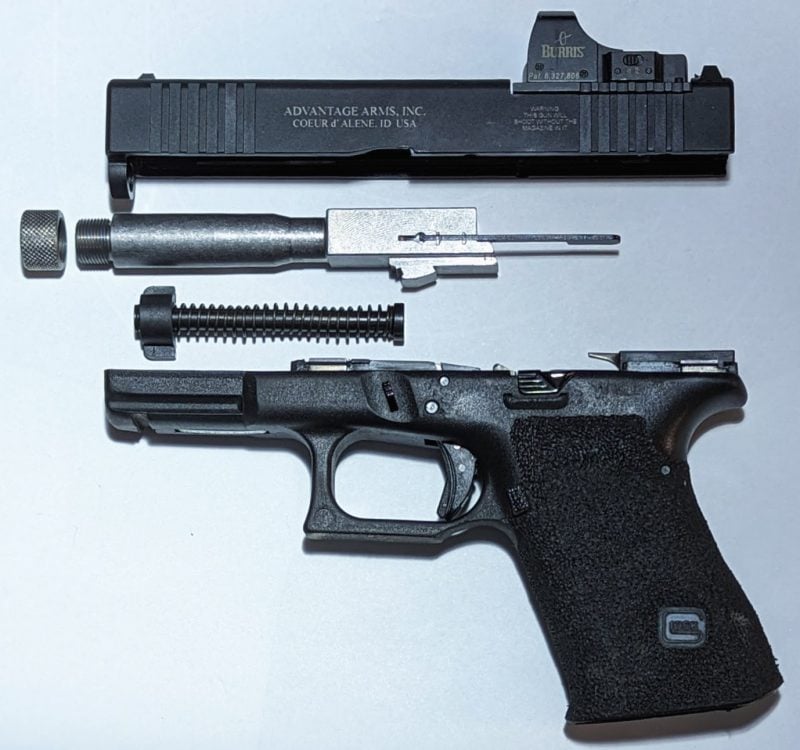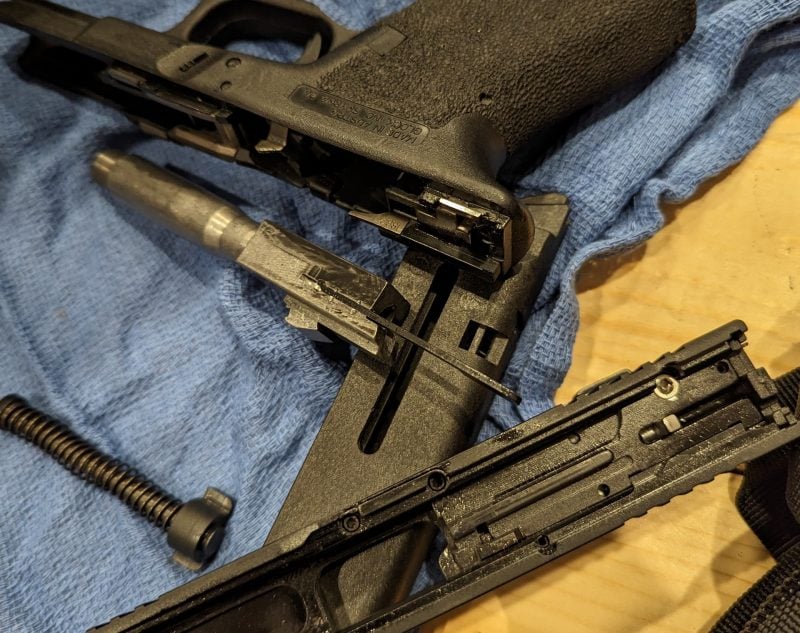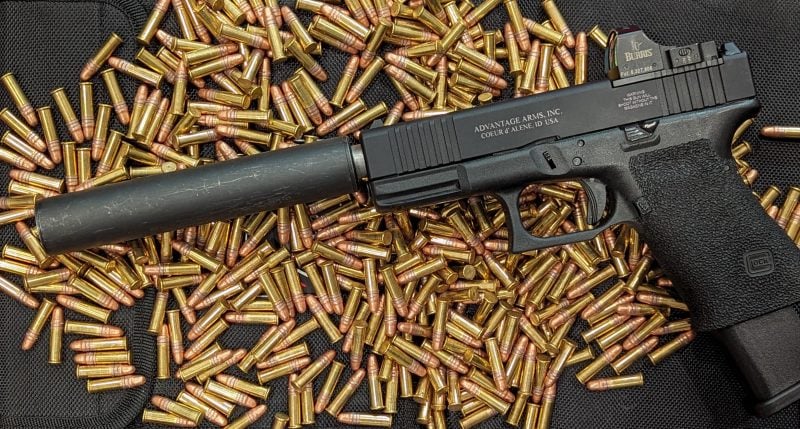Unless you’ve lived under a rock for the last decade or so, you know ammo prices have been highly volatile. Regardless of caliber, prices have skyrocketed as political and global winds sway consumer demand and affect the cost of materials. Throughout it all, .22LR remained the cheapest ammunition available to consumers. For the budget-conscious, .22LR conversion kits from companies like CMMG and Advantage Arms are incredibly attractive.
While I purchased my first .22LR conversion kit for the AR-15 nearly 20 years ago, I’ve dawdled on purchasing a pistol kit. As an admitted Glock fanboy, I eventually wanted to obtain one of Advantage Arms’ .22LR Glock conversion kits. I finally satisfied that desire when an Advantage Arms conversion kit for the Glock 19/23 showed up on my doorstep.
Advantage Arms Background
Advantage Arms is far from the new kid on the block in the gun industry. Founded in California in 1997, Advantage Arms specializes in manufacturing .22LR conversion kits for many popular firearms. Eventually, they strategically relocated to mildly more gun-friendly Idaho.
Over time, Advantage Arms expanded their product lineup to include more than just Glock pistols. They now offer .22LR conversion kits for the Springfield XD, PSA Dagger, and 1911/2011 pistols. At the 2022 SHOT Show, Advantage Arms showcased prototypes for the Sig P365 and Springfield Hellcat. They definitely aren’t the kind of company comfortable with the status quo.
Advantage Arms .22LR Glock Conversion Kit
When shopping for a .22LR conversion kit, I ultimately settled on Advantage Arms’ conversion kit for the Gen3 Glock 19/23. Since my old Glock 23 Gen3 sat unfired for the last two years, it was sensible to offer that pistol as a sacrifice to the rimfire gods.
Accessories
The conversion kit arrived with a surprisingly nice soft case. While not a deal-breaker, I didn’t expect a full package and would have been satisfied with just the slide and a magazine. The case included two 15-round magazines, a Glock-style magazine loader, and a .22LR conversion slide. A detailed instruction manual was included with clear instructions on operation, maintenance, and recommended ammunition.

The mag loader worked surprisingly well with the magazines. I saw a Glock-style mag loader and wrote it off as cheap. My impression was wrong as it worked fantastic and made loading mags easy. However, I’ll offer one pro tip about the magazine loader. When loading the magazines, use your thumb to capture the tip of the round while it’s in the magazine before releasing pressure from the mag loader. The first few rounds like to pop nose up out of the magazine if you don’t do this. Otherwise, the mags were easy to load.

Installation
Installing the Advantage Arms .22LR Glock conversion kit was intuitive and simple. If you can field strip and re-assemble a Glock, then you can install this kit. This particular model included a threaded barrel and is “suppressor ready” (this is in quotes for reasons I’ll discuss later). The guide rod spring assembly is captured like a normal Glock, so the spring won’t unintentionally rocket across the room during disassembly.

Before firing the conversion kit, I strongly recommend reading the instruction manual in its entirety. This saves some heartache and answers a few questions you may have along the way. In my case, excitement got the better of me, and I fired two frustrating magazines of malfunctioning ammo. Upon returning to the instructions, I realized I failed to properly lubricate the conversion kit. After some lubrication, I was back on the range with better results.
Features
Before delving into the Advantage Arms conversion kit’s performance, let’s discuss some other features. When first introduced to Advantage Arms around 2012, pistol optics weren’t common. Obviously, a lot has changed in a decade. With those changes, Advantage Arms followed suit with optics-ready conversion kits.

This conversion kit was optics-ready with an installed plate cover. I grabbed an old Burris FastFire and a spare Glock MOS plate to add to the kit. Advantage Arms made installation easy with the torque spec (10 ft-lbs) printed on the slide beneath the plate cover. While it would be more convenient to include MOS plates with the kit, it’s not necessary with how prolific and easily obtainable MOS plates are. With a brief sight-in, I ran the pistol on steel plates with child-like glee.
On the Range
When I first hit the range with the conversion kit, I didn’t read the directions in their entirety (e.g. at all). After an infuriating two magazines, I discovered the value of reading comprehension and appropriately lubricated the conversion kit as directed. I ran the gun through some more mags and found it increasingly reliable. After about 60 rounds of Federal Auto Match, I transitioned to CCI AR Tactical and MiniMag with phenomenal results.
When I say “phenomenal,” it needs some context. Rimfire cartridges are a whole different breed — especially bulk .22LR. If I experienced a malfunction every 50 rounds with 9mm, the gun or ammo would undergo significant scrutiny. With rimfire, that’s a good run. The Advantage Arms conversion kit ran exceptionally well with occasional malfunctions to be expected from .22LR.

The instruction manual provided by Advantage Arms is extremely helpful. It has the kind of nuanced detail I expect from a company run by actual shooters. For example, the instructions list different tiers of ammunition recommendations. Advantage Arms strongly recommends high velocity .22. Some examples are CCI MiniMag and AR Tactical, Remington Golden Bullet, or Federal Auto Match.
After a 500-round range session, I was thoroughly impressed by the conversion kit. As it got filthier, malfunctions increased as expected with rimfire. Most of the issues I attribute to shooter error (as a lefty, my thumbs tend to interfere with rimfire ejection ports) or the quirks and inconsistencies of rimfire ammunition. The kit shot reliably and, with the optic, consistently hitting steel plates from 30 yards was exceptionally easy. The 15-round mags ran without any feeding issues and the slide consistently locked back on the last shot.
The instruction manual offers a golden tidbit of advice for improving the conversion kit’s reliability. What’s the tip? Lubricate your ammunition. Yup, you read that correctly. They recommend applying a light coat of oil to improve ammunition reliability. I tried this with some inconsistently performing Federal Auto Match. I shot some oil on an old rag and placed a handful of ammo on it. The ammo then got a shot of light oil (e.g. WD-40, G96, etc). After rolling the ammo around in the rag to distribute the oil, I immediately loaded a few mags. The ensuing reliability was spectacular. After 500 rounds, I’m a massive fan of this conversion kit.
Running Suppressed
Earlier, I mentioned how the threaded barrel made the kit “suppressor ready”. Unfortunately, that wasn’t the case when used in conjunction with my Yankee Hill Mite .22 suppressor. The suppressor weight caused the slide and barrel to bind some, slowing its cycling speed. As a result, the slide didn’t always close into battery completely.

I can’t really blame Advantage Arms for this one. While a great rimfire suppressor that’s served reliably over the years, the YHM Mite is heavy compared to modern rimfire suppressors. The Mite is decade-old technology and this kit wasn’t built around that. Eventually, I’ll revisit suppressing the kit when I acquire a more modern lightweight rimfire suppressor. Until then, I’m happy ringing steel with this pistol unsuppressed.
Advantage Arms .22LR Conversion: Yay or Nay?
Rimfire is notoriously unreliable and inconsistent. Many rimfire conversion kits are even more notorious. After all, rimfire kits convert a full-power centerfire firearm to rimfire and that doesn’t always yield great results. Furthermore, rimfire is finicky. Performance varies wildly by ammo lot number and that’s before considering the firearm make and model. However, like my experience with CMMG’s .22LR AR-15 conversion kit, the Advantage Arms .22LR kit is a huge “Yes” from me. Advantage Arms has built a reliable conversion kit and gives the guidance to maximize your success.
Advantage Arms conversion kits cost about the same as a new rimfire pistol, and vary from $285 to just south of $400. While this may seem pricey, here’s some perspective. Bulk target 9mm consistently runs around $270 for 1,000 rounds whereas bulk .22LR runs around $80 per 1,000 rounds. If you shoot regularly, a rimfire conversion kit is a great investment and pays for itself within 2,000 rounds. It’s also extremely fun and a great training tool for new shooters and little ones. Furthermore, if wanting to train on an existing frame within your collection (mine are stippled and modified to my liking), Advantage Arms is a winner. Now, if you’ll excuse me, I have some more rimfire ammo to put downrange.


